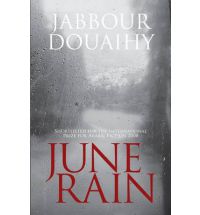This article was last updated on April 16, 2022
Canada: ![]() Oye! Times readers Get FREE $30 to spend on Amazon, Walmart…
Oye! Times readers Get FREE $30 to spend on Amazon, Walmart…
USA: ![]() Oye! Times readers Get FREE $30 to spend on Amazon, Walmart…
Oye! Times readers Get FREE $30 to spend on Amazon, Walmart…
abbour Douaihy’s novels have been acclaimed and awarded in the last few years, both in Arabic and in French translation. Now, with a new translation of his June Rain by Paula Haydar, one hopes the Lebanese author will begin attracting admirers in English, too:
On the face of it, Jabbour Douaihy’s “June Rain” doesn’t look like a mystery novel. We generally know who’s at fault in the novel’s main crime, a shoot-out in a village church. But because it was committed by so many in the village shooting so wildly, it isn’t clear how any particular person died. Which of the victims were also shooters? Which were caught in the crossfire? As the novel progresses, Eliyya Kfoury, who stands at the narrative’s centre, comes back to the village of Barqa to find out more about his father’s death in 1957.
“June Rain” is not the first Lebanese novel to examine a single murder among many. Beginning perhaps with Elias Khoury’s “White Masks” (1981), there have been a number of literary “whodunits” that have searched, against a backdrop of civil conflict, for a murderer among murderers.
In Douaihy’s novel, as in the others, these murderers don’t just go unfound – the narrative gives up on finding them. In “White Masks”, the narrator decides that “who did it” is the wrong question. In Rabee Jaber’s “Mehlis Report” (2005), the whole of Beirut follows a UN tribunal’s search for Prime Minister Rafik Hariri’s killer. None is found. No one really expects them to find one.
Warmth and humour
All three of these excellent novels come to a similar conclusion: in circumstances like these, it is impossible, or unnecessary, to find the “who” of the whodunit. All three are intellectually and aesthetically satisfying reads, but Douaihy’s novel has something the others lack: a warmth and humour that enlivens each of its many characters.
Douaihy’s book opens in 1957, long before the start of Lebanon’s 15-year civil war. Although most of the action happens either before 1975 or after 1990, the civil war is ever-present, and Douaihy doesn’t gloss over day-to-day violence or the country’s increasing polarisation. Indeed, a search for the roots of violence is central to the story. But even though violence is ever-present, the narrative never loses its gentle sense of humour nor its affection for its characters.
“June Rain” begins as a tragedy: children at a boarding school outside their village are informed that they will go home early, yet no one will explain why. The children slowly understand what’s happened, and so does the reader. A shoot-out during a funeral service has led to some two dozen deaths, a massive number in such a tiny village.
Throughout the book, this is how we learn about events. We are never an insider, and we never enter the minds of any of the major movers and shakers. Instead, we hear about violence from ordinary children, men and women, some of whom are just trying to get by, some of whom are fomenting hate against their neighbours.
Click HERE to read more


Be the first to comment